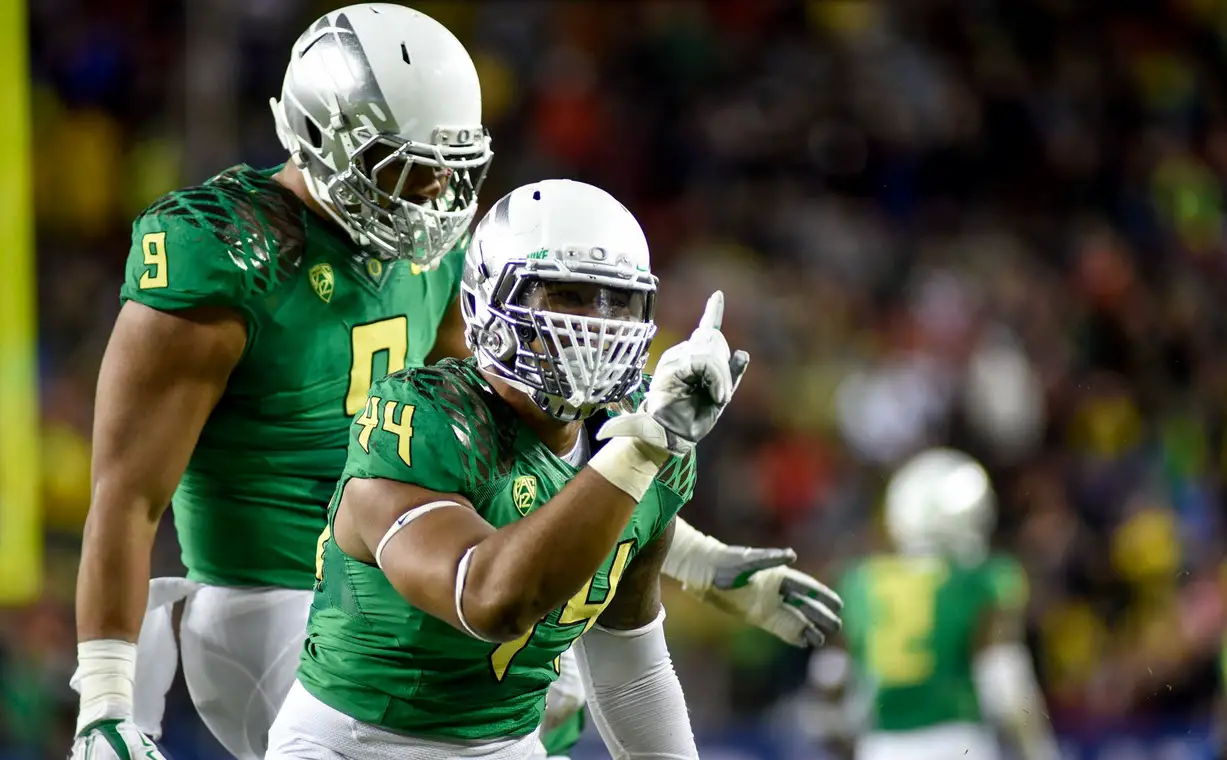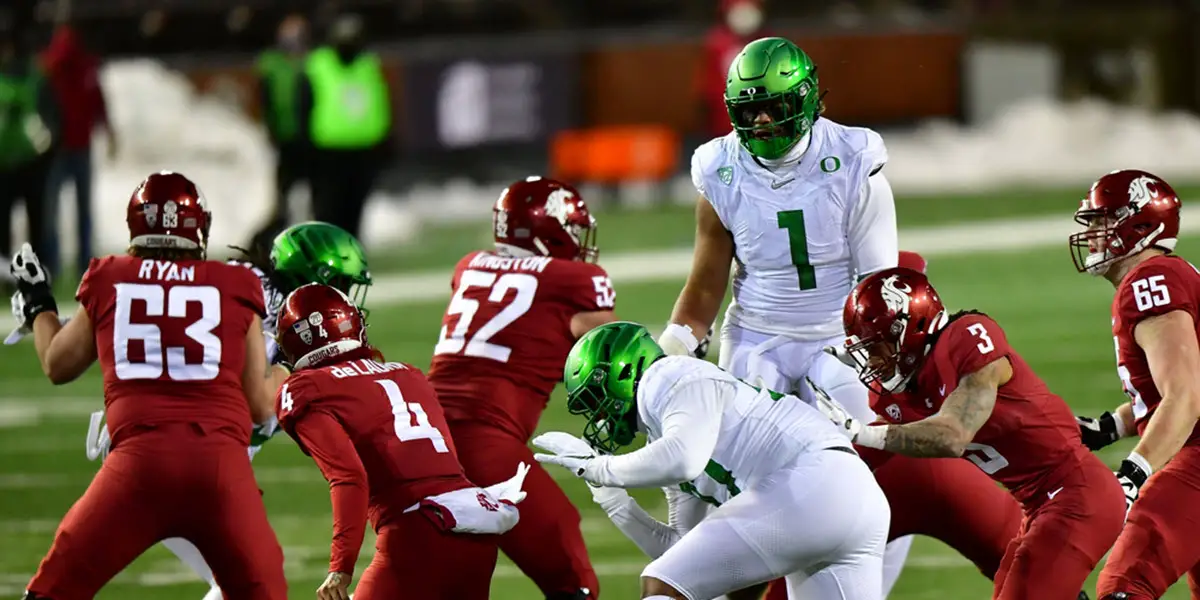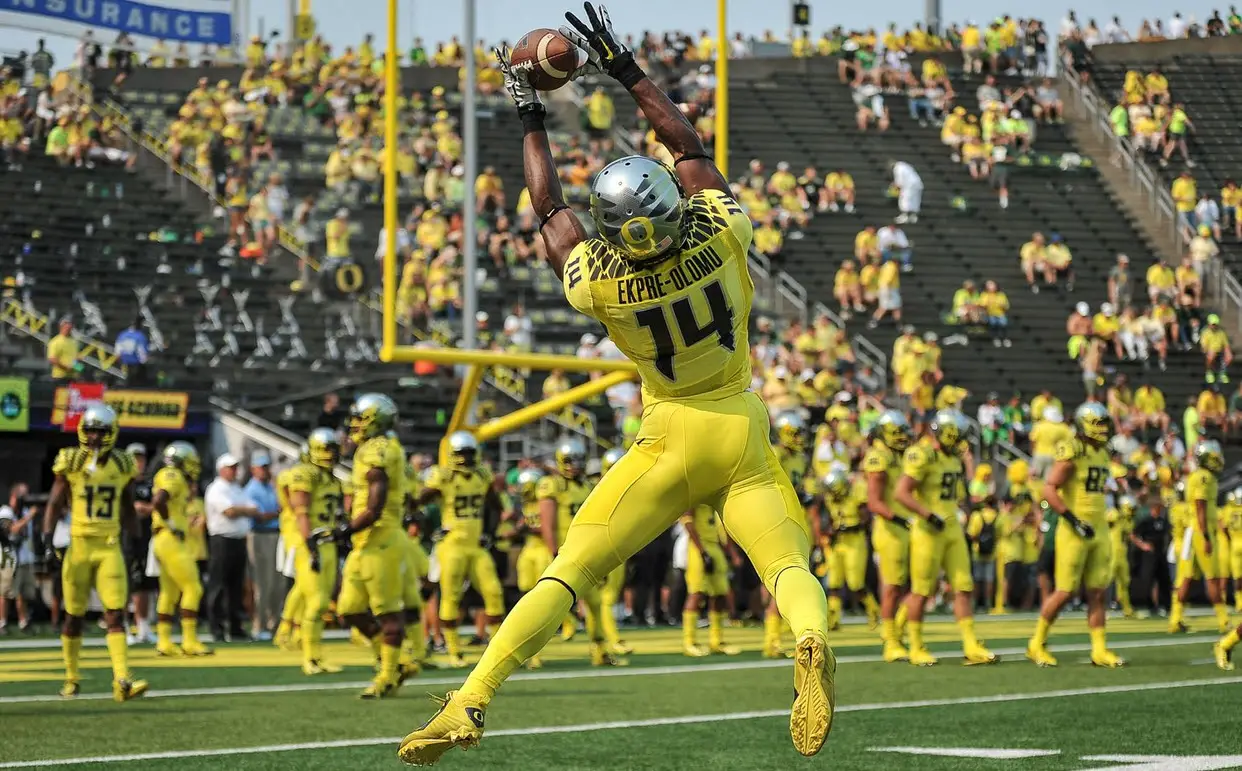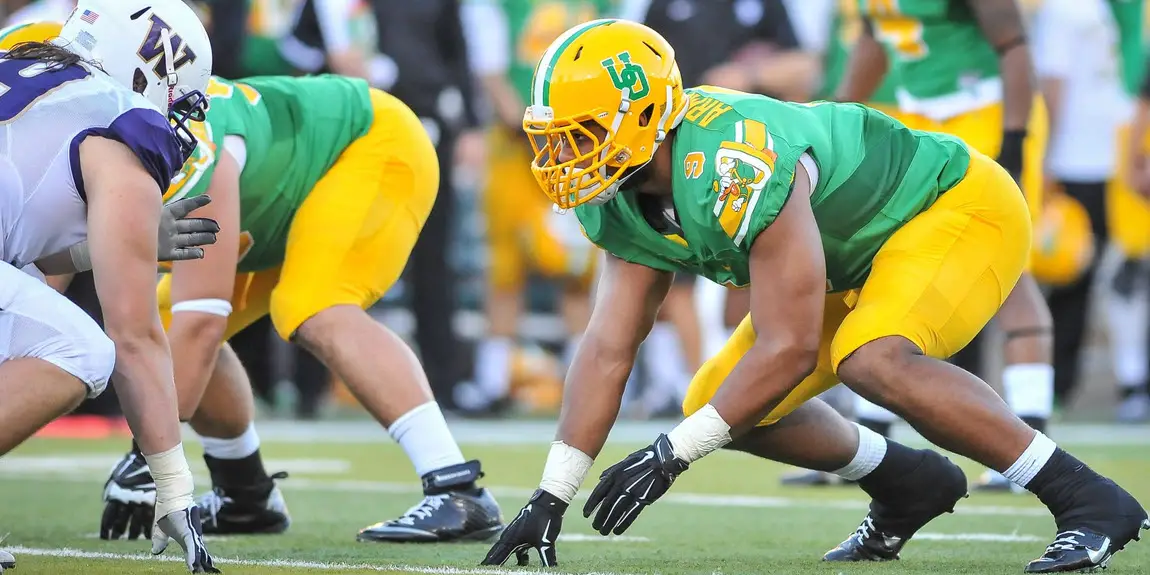Oregon’s 2021 football team has the hype and personnel to make a run at the College Football Playoff and maybe even a National Championship. Last week, I looked at how this year’s offense stacked up against the 2014 team, and today we turn to the defense to compare 2021’s team to the last Oregon team to reach the Playoff and National Championship Game.
The Defensive Line
The defensive line is full of unknowns in 2021, but this squad also possesses a great deal of potential. Players like Brandon Dorlus, Kristian Williams and Popo Aumavae have been impact players the past couple of seasons, and that trend will need to continue to have success in 2021. Kayvon Thibodeaux is by far the most disruptive piece of this defensive front. Thibodeaux was the highest-rated recruit in Oregon’s history and has been a terror to opposing offenses for the past two years. This defensive line showed great potential by creating pressure during the the Pac-12 Championship Game and, most recently, during the Spring Game. When the season starts this should be one of Oregon’s most consistent units.
But how do they stack up against the last Oregon team to reach the Playoff, the 2014 Ducks? The 2014 Ducks had two top ten NFL draft picks in Arik Armstead and DeForest Buckner on the line. Both of these players have also gone on to highly successful NFL careers. During their time at Oregon, they stood as literal giants along the defensive line.

DeForest Buckner and Arik Armstead were massive parts of the 2014 Oregon defense.
In terms of talent, it would seem the 2014 Ducks are the more talented group, though the big difference between these groups will come down to the scheme. In 2014, Defensive Coordinator Don Pellum opted to rush three and drop eight into coverage on a regular basis. This usually resulted in the defensive linemen eating blockers and fighting off frequent double teams. The result was that if the defensive line was against a quality opponent, such as Ohio State, they couldn’t pressure the quarterback and relied almost solely on linebackers to truly defend against the run. This was ineffective.
Oregon’s current defensive coordinator, Tim DeRuyter, has a different scheme in which he likes to put more pressure on the quarterback with a variety of packages. As a result, we will see Oregon’s defensive line set up more opportunities for Oregon’s linebackers to make big plays. For the defensive line, in particular, scheme is going to potentially outweigh talent in 2021, even though this line has plenty of quality, if young, talent.
Player Skill Advantage — 2014 Ducks
Overall Advantage — 2021 Ducks
Linebackers
The 2014 linebackers had some big names for Oregon at the time: Tony Washington, Torrodney Prevot, Rodney Hardrick, Derrick Malone Jr and Joe Walker to name a few. The linebackers on this defense were central to its success and, at times, its failures. However, even with all those names on the roster, none of them have anywhere near the potential of Oregon’s current linebacker corps.

Noah Sewell had a great start as a freshman and will continue to grow in 2021.
Noah Sewell, Justin Flowe, Isaac Slade-Matautia, Mase Funa, Adrian Jackson and Keith Brown all have more potential than the 2014 Duck linebackers. Sewell is already a household name, and Flowe is poised to become a breakout star this upcoming year (he was forced to sit out in 2020 due to injury). There is just more raw talent and physicality on the 2021 team.
Advantage — 2021 Ducks
The Secondary
The 2014 defense led the country in turnover margin and much of that was due to an incredible ball-hawking secondary. Erick Dargan led this secondary with seven interceptions. Combine that with lock-down corners Ifo Ekpre-Olomu and Troy Hill, and this secondary was incredibly difficult for quarterbacks to pass against. There was some depth in the 2014 secondary, as it was full of future Oregon stars, but when Ekpre-Olomu was injured before the Rose Bowl game, he was replaced by Chris Seisay, who served admirably but lacked the ability of Ekpre-Olomu.
The 2021 secondary has star power in Mykael Wright, experience in DJ James and immense potential in Dontae Manning, but for the most part the cornerbacks may prove to be an initial weakness for this Oregon team. There isn’t a whole lot of experience in this group, though there is a plethora of talent. This is one of the youngest position groups on an already young team.
The 2021 Ducks look more secure at safety with Verone McKinley III and Jamal Hill both entering their second year as full-time starters. Both have shown some ball hawking ability and, if given the opportunity, will be around the ball on almost every snap. Bennett Williams and Jordan Happle will both see the field this year and at the very least provide some depth at the safety position. Though, like cornerback, the safety position has yet to truly prove itself and will need new faces to step up for this to unit to be truly special.
Advantage — 2014 Ducks

Ifo Ekpre-Olomu is an Oregon legend at cornerback and was a nightmare for quarterbacks.
Conclusion
The 2014 defense was good, but not great. Its success was helped by the fact that the 2014 offense could score on demand, led by Marcus Mariota. The defense could allow some points because the offense was simply just going to score more. The 2021 defense does not have that luxury with a mostly unproven offense, though one with incredible potential.
The 2021 defense has more potential everywhere on the field, but they are a much, much younger team. While the 2014 defense consisted mostly of juniors and seniors, the 2021 defense is composed mostly of sophomores and freshmen (at least in terms of eligibility due to the strange COVID-19 season).
The biggest difference between the two defensive units is the coordinator, and that advantage goes decidedly to 2021 with DeRuyter. DeRuyter should engineer a defense far more aggressive and physical than Pellum’s. At the same time, 2020 was a major step back defensively. How quickly will DeRuyter have this Oregon defense back to one of the top defensive units in the Pac-12 and in the country?
David Marsh
Portland, Oregon
Top Photo By: Kevin Cline
 Andrew Mueller, the FishDuck.com Volunteer Editor for this article, works in higher education in Chicago, Illinois.
Andrew Mueller, the FishDuck.com Volunteer Editor for this article, works in higher education in Chicago, Illinois.

David Marsh is a high school social studies teacher in Portland, Oregon. As a teacher he is known for telling puns to his students who sometimes laugh out of sympathy, and being both eccentric about history and the Ducks.
David graduated from the University of Oregon in 2012 with Majors in: Medieval Studies, Religious Studies, and Geography. David began following Ducks Football after being in a car accident in 2012; finding football something new and exciting to learn about during this difficult time in his life. Now, he cannot see life without Oregon football.

